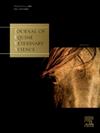形态学试验中克里奥罗马的形态计量参数、代谢剖面和肌肉骨骼变化。
IF 1.6
3区 农林科学
Q2 VETERINARY SCIENCES
引用次数: 0
摘要
背景:肥胖在某些马品种中很常见,这引起了人们对健康和表现的担忧。克里奥罗马在形态事件中经常经历强化管理,促进早期肥胖。目的/目的:本研究旨在(1)评估参与形态学试验的Criollo马的形态特征、代谢特征、蹄形态和跗骨关节变化;(2)评估性别相关差异;(3)形态测量、蹄形态和跗骨关节炎分级之间的关系。方法:对55匹马(母马30匹,种马25匹)进行体况评分(BCS)、颈冠评分(CNS)、形态计量学测量和代谢指标(胆固醇、脂蛋白、瘦素、脂联素、肌酶)的测定。分析前肢蹄片(n=49)的形态,分析跗骨关节片(n=48)是否存在退行性改变。结果:观察到高患病率超重马(BCS≥7)。结论:这些发现突出了Criollo品种形态学试验中超重动物的普遍存在以及该种群中跗骨关节变性的发生。蹄测量和肥胖变量之间的关联强调了身体状况升高对肌肉骨骼改变和板炎发展的潜在影响。本文章由计算机程序翻译,如有差异,请以英文原文为准。
Morphometric parameters, metabolic profile and musculoskeletal alterations in Criollo horses competing in the morphology trial
Background
Obesity is common in some horse breeds, raising concerns about health and performance. Criollo horses in morphological events often undergo intensive management promoting early adiposity.
Aims/objectives
This study aimed (1) to assess morphometric traits, metabolic profile, hoof morphology, and tarsal joint alterations in Criollo horses participating in morphological trials; (2) to evaluate sex-related differences; and (3) the associations between morphometric measurements, hoof morphology, and tarsal osteoarthritis grades.
Methods
Fifty-five horses (30 mares, 25 stallions) were evaluated for body condition score (BCS), cresty neck score (CNS), morphometric measurements and metabolic parameters including cholesterol, lipoproteins, leptin, adiponectin and muscle enzymes. Forelimb hooves (n = 49) radiographs were analyzed for morphology and tarsal joints (n = 48) radiographs were analyzed for the presence of degenerative alterations.
Results
A high prevalence of overweight horses (BCS ≥7) was observed. Males had greater neck circumference (p < 0.05), females had higher body fat percentage (p < 0.05). Distal phalanx descent correlated positively with body fat (r = 0.31, P = 0.01) and tailhead fat (r = 0.31, P = 0.01). Distal lamellar zone distance positively correlated with body fat (r = 0.34; P = 0.009) and tailhead fat (r = 0.34; P = 0.009), and hoof angle correlated negatively with neck fat (r=-0.41; P = 0.02). Males showed longer P2 (p < 0.05). All horses had tarsal radiographic lesions; females exhibited higher lesion scores than males (p = 0.005).
Conclusion
These findings highlight the prevalence of overweight animals in Criollo breed morphological trials and the occurrence of tarsal joint degeneration in this population. The association between hoof measurements and adiposity variables emphasizes the potential impact of elevated body condition on musculoskeletal alterations and laminitis development.
求助全文
通过发布文献求助,成功后即可免费获取论文全文。
去求助
来源期刊

Journal of Equine Veterinary Science
农林科学-兽医学
CiteScore
2.70
自引率
7.70%
发文量
249
审稿时长
77 days
期刊介绍:
Journal of Equine Veterinary Science (JEVS) is an international publication designed for the practicing equine veterinarian, equine researcher, and other equine health care specialist. Published monthly, each issue of JEVS includes original research, reviews, case reports, short communications, and clinical techniques from leaders in the equine veterinary field, covering such topics as laminitis, reproduction, infectious disease, parasitology, behavior, podology, internal medicine, surgery and nutrition.
 求助内容:
求助内容: 应助结果提醒方式:
应助结果提醒方式:


